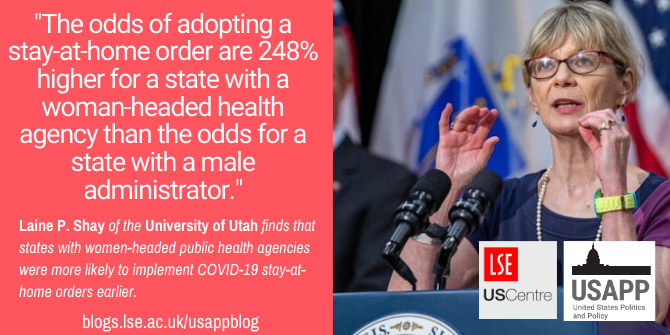 Much of the US response to the COVID-19 pandemic has been the responsibility of state governments, with some issuing stay-at-home orders earlier than others, and some not issuing them at all. In new research which analyses the timing of state stay-at-home orders, Laine P. Shay finds that Democratic states were over 400 percent more likely to implement early stay-at-home orders, and almost 250 percent more likely if their state public health agency was headed by a woman.
Much of the US response to the COVID-19 pandemic has been the responsibility of state governments, with some issuing stay-at-home orders earlier than others, and some not issuing them at all. In new research which analyses the timing of state stay-at-home orders, Laine P. Shay finds that Democratic states were over 400 percent more likely to implement early stay-at-home orders, and almost 250 percent more likely if their state public health agency was headed by a woman.
To manage the coronavirus pandemic, since mid-March several US states adopted a stay-at-home order. A stay-at-home order only allows individuals to leave their home for essential business as designated by the state government. Gyms, restaurants, schools, and other small businesses were forced to close their doors. The goal of this policy was to flatten the curve and slow the spread of the coronavirus. On March 19, California was the first state to implement a stay-at-home order; a few states, such as Iowa and Utah, have yet to issue a stay-at home-order. This variation raises the following question, which I look at in new research: what factors account for when a state adopts a stay-at-home order?
I hypothesize that the gender of state executive branch policymakers may be a factor. Recent research shows that a state policymaker’s gender can influence their policy choices. While this is not an undisputed claim, studies show that women policymakers tend to be more liberal than their male counterparts. If women policymakers are indeed more liberal, then we might see them advocate for the implementation of a stay-at-home order. Implementing a stay-at-home order requires government intervention in the economy, a decision that some conservative policymakers may object to.
Additionally, research shows that healthcare tends to be a policy area that is more important and prioritized by women policymakers than their male counterparts. I argue that since women policymakers tend to prioritize healthcare, then we might see women state policymakers advocating for stay-at-home orders more strongly. Thus, I expect that women executive branch policymakers might be more likely to quickly adopt stay-at-home orders than male policymakers.
With this in mind, I examine the impact that gender has on two executive branch policymakers. First, in most states the governor has the ultimate say, if a stay-at-home order is adopted. Second, I examine whether the gender of public health agency heads has any impact on the timing of stay-at-home orders. These administrators are responsible for advising the governor on public health issues in the state. These executive administrative officials also interpret policy information to the state’s chief executive. Thus, my expectation is that women governors and states with a women-headed public health agency will tend to adopt stay-at-home orders earlier than states with male agency heads and governors.

Massachusetts Secretary of Health and Human Services Marylou Sudders. “Baker-Polito Administration provides COVID-19 update on reopening plans, responds to recent demonstrations” by Charlie Baker is licensed under CC BY NC SA 2.0
To test this expectation, I analyzed the amount of time until a state will issue a stay-at-home order. I start my analysis the day after President Trump declared a national emergency due to COVID-19, and ended it on April 18. Figure 1 shows the different time periods in which a state adopted a stay-at-home order. States that are a lighter shade implemented their stay-at-home order more quickly. Conversely, states that are shaded darker implemented their order later.
Figure 1 – Timing of stay at home order for COVID-19 by state

Notes: Data is from Shay (2020). Lighter shaded states adopted a stay-at-home order earlier than the darker shaded states.
I find that the gender of the governor has no impact on the likelihood of a state adopting a stay-at-home order. However, the gender of the public health administrator does impact when a state will adopt such an order. I find that states with a women-headed health agency tend to adopt stay-at-home orders earlier than states with a male administrator.
In Figure 2, I show this relationship with the percentage change in the odds of a state adopting a stay-at-home order. A positive change indicates that a state will adopt an order earlier. The odds of adopting a stay-at-home order are 248 percent higher for a state with a women-headed health agency than the odds for a state with a male administrator. I also plot the other factors that are statistically significant and influence the adoption of stay-at-home orders. I briefly discuss a few of the other major factors that influence the timing of such policy adoptions. For instance, I find the odds of a state adopting an order are 413 percent higher with a Democratic governor than the odds for a state with a Republican governor. Additionally, I find that a one percent increase in the Hotel/Small Business interest groups represented in a state is associated with a 35 percent decrease in the odds of a state adopting a stay-at-home order.
Figure 2 – Factors which influence the timing of stay at home orders

Notes: Estimated from Shay (2020). Presented are the percent change in the odds of a state adopting a stay-at-home order. Positive values indicate that a state is more likely to adopt an order early. Negative values indicate that a state adopts a stay-at-home order later.
My findings suggest that the gender of the state’s chief executive does not influence the timing of stay-at-home orders. However, I also find that public health agencies which are headed by a women administrator result in a state more quickly adopting a stay-at-home order. These results imply that the gender of bureaucratic administrators that advise the governor can be a pivotal actor on key policy decisions. These findings highlight the importance of women leadership in the executive branch. This contradicts the claim by some politicians which question the importance of diversity in the bureaucracy. My findings suggest that diversity can be crucial in terms of policy outcomes. Additionally, health experts have recommended that stay-at-home orders can help to contain and limit the spread of COVID-19. My findings imply that stay-at-home orders might be adopted quicker if women hold certain leadership positions in the executive branch.
- This article is based on the paper, ‘Closing Time! Examining the Impact of Gender and Executive Branch Policymakers on the Timing of Stay-at-Home Orders’ in Politics and Gender.
Please read our comments policy before commenting.
Note: This article gives the views of the authors, and not the position of USAPP – American Politics and Policy, nor the London School of Economics.
Shortened URL for this post: https://bit.ly/3hkSf4s
About the author
 Laine P. Shay – University of Utah
Laine P. Shay – University of Utah
Laine P. Shay is an Assistant Professor in the Department of Social Science. He studies American institutions, executive branch politics, and state politics.






